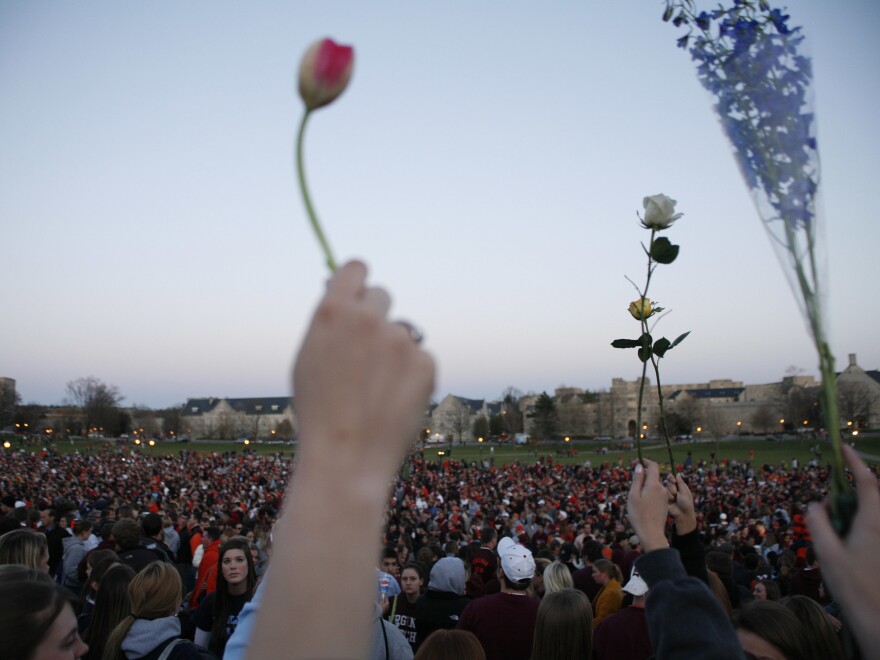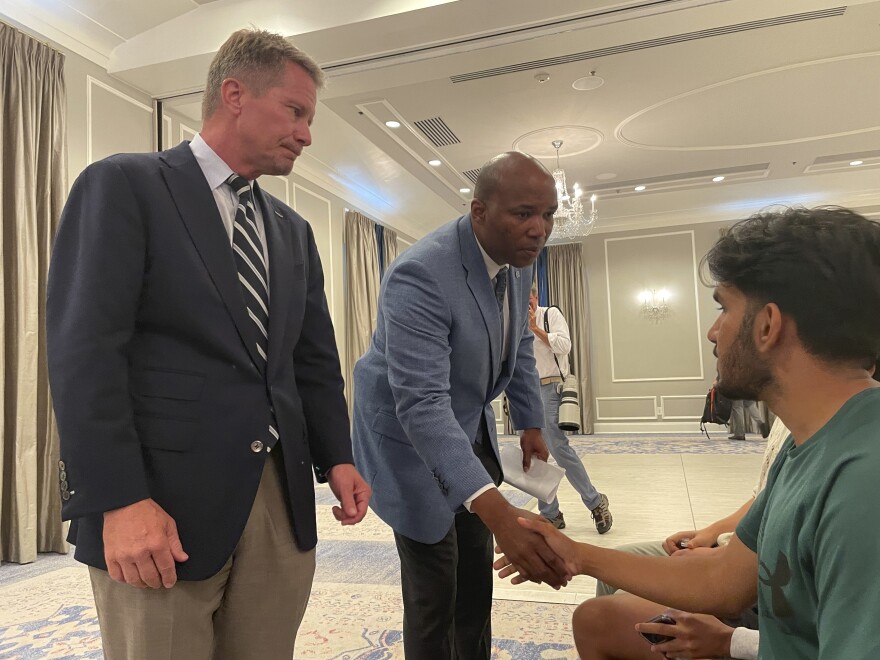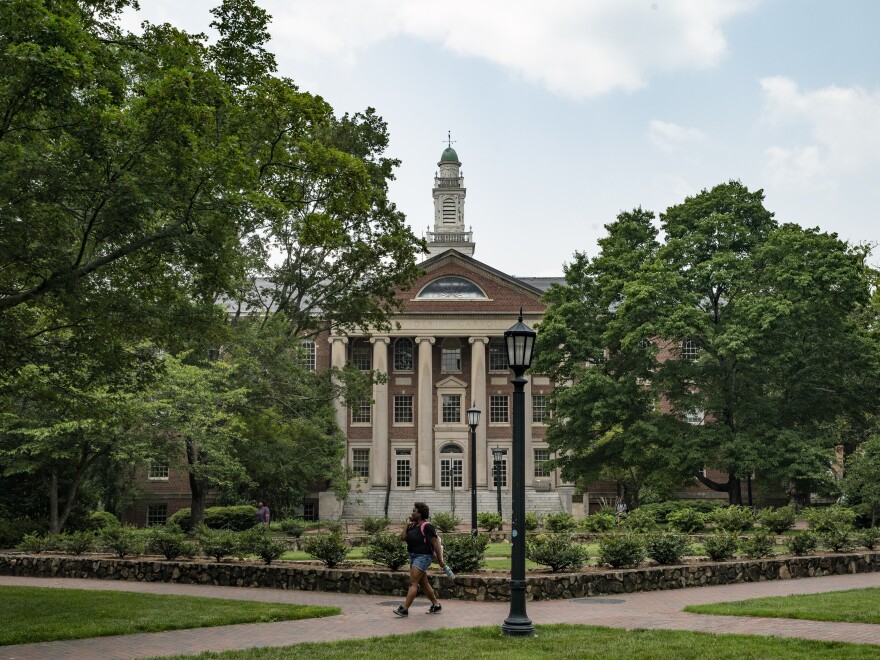Updated August 29, 2023 at 1:55 PM ET
Two tragedies just three days and several hundred miles apart from each other are drawing renewed attention to security on college campuses.
On Monday, the University of North Carolina at Chapel Hill spent more than three hours in lockdown as an armed assailant roamed campus and was ultimately taken into custody after fatally shooting a faculty member.
On Saturday, a gunman drove onto the campus of Edward Waters University, a historically Black university in Jacksonville, Fla., with a bulletproof vest, gloves and mask. Concerned students alerted a public safety officer, who approached the car. The driver sped away — then shot and killed three Black people at a nearby Dollar General store. The incident is now being investigated as a hate crime.
Florida Gov. Ron DeSantis has since directed $1 million toward campus security at Edward Waters University – in addition to $100,000 for the victims' families. His office said the Florida Department of Law Enforcement has also started visiting the campus, monitoring social media for any additional threats, and working with the university to assess its security infrastructure.
In North Carolina, Gov. Ron Cooper has said the state will provide "any assistance necessary" to support the UNC community. And Chancellor Kevin Guskiewicz says the school will offer counseling services and "opportunities to grieve and process."
"This shooting damages the trust and safety that we so often take for granted on our campus," he said in an announcement. "We will work to rebuild that trust and safety."
On one campus, a community is hailing some of its members as heroes, even as it grieves the loss of life nearby. On another, students — many of whom spent hours barricaded in dorm rooms and classrooms (with some even jumping out of windows) — are left shocked and shaken.
Together, they raise questions, like: How great is the threat to university campuses?
And what can be done to make them safer?
Steven Healy, the CEO of the Healy+ Group — a firm that specializes in campus security — told Morning Edition that campus and security officials must have "active violence situations" on their radar.
"There's no way that we can categorically dismiss an incident like this, and so it has to be part of our ongoing risk assessment," he said. "We have to think about, what are we doing to both prevent such an event but also to be able to respond if a tragedy like this happens on our campus as we saw unfolding at Chapel Hill."
What we've learned

Attacks on higher education campuses in the U.S. are relatively rare, difficult to define, and are not centrally tracked, PBS NewsHour reported in February of this year, after a gunman killed three people and injured five others at Michigan State University.
At that time, at least 98 people had been killed in 12 mass shootings at U.S. colleges since 1966, according to research from the Violence Project and Best Colleges. Of those, 75% took place within the last 16 years.
Another 94 people were killed in at least 308 instances of gunfire — including individual attacks, legal intervention and self-harm — on college campuses between 2013 and 2022, reports Campus Safety magazine, citing the nonprofit Everytown for Gun Safety.
The deadliest mass shooting on a university campus happened at Virginia Tech in 2007, when a former student killed 32 people and injured 23.
That tragedy transformed the entire emergency preparedness industry, as Campus Safety reported. Up until that point, the few preparedness officers at schools were predominantly focused on natural disasters.
In the wake of Virginia Tech, schools, state governments and federal agencies reshaped their policies and protocols to improve campus safety and their emergency response.
Virginia Tech survivor Kristina Anderson Froling told Morning Edition earlier this year that one of the biggest changes was the recommendation that schools should create collaborative threat assessment teams. Those are typically composed of officials in mental health, education and law enforcement that can work together to identify threats and troubling behavior before they escalate to violence.
She said while we often think of campus security in physical terms, it's more nuanced — and all-encompassing — than that.
"I think that that true sense of safety is, how invested are we as an individual?" she explained. "Has this school really put forth a plan? Are there activities around safety and security? Does every person feel connected to that institution? And do they care enough that they will report a broken window or a lock that should be fixed?"
What we can do

Colleges must strike a delicate balance between keeping their campuses open and keeping their students safe, according to both Froling and Healy.
"We're trying to create and maintain an open environment that is welcoming, obviously, for our students, staff and faculty but also to the general public, who want to come on the campus and enjoy," Healy said. "At the same time we have to provide a reasonable level of safety and security."
He stressed the importance of proactively recognizing and understanding potential threats.
"When we talk about behavioral threat assessment, we're talking about being able to assess whether there's someone who's connected with the campus, connected with the institution, who we know may be experiencing some ... proclivity toward violence," he said.
At the same time, he said, schools must have robust critical incident management programs, including detailed plans for switching from normal to emergency operations.
"That's not what we do in higher education on a regular basis, so we have to have policies, procedures and training around that," he added.
Campus Safety recommends a range of steps schools can take, like conducting regular drills addressing a whole range of hazards, training staff on verbal de-escalation techniques and hiring security contractors as well as campus psychologists and social workers.
Healy said campus security involves a combination of precautions, from the equipment to the intelligence.
"The behavioral threat assessment helps us with the prevention," he added. "And our response capability, what do we do if a situation like this unfolds — are we able to notify the campus community, do folks know what to do — and are we able to intervene in such an incident."
The broadcast interview was produced by Julie Depenbrock.
Copyright 2024 NPR. To see more, visit https://www.npr.org.



